MERCEDES-BENZ E-CLASS CABRIOLET 2010 Workshop Manual
Manufacturer: MERCEDES-BENZ, Model Year: 2010, Model line: E-CLASS CABRIOLET, Model: MERCEDES-BENZ E-CLASS CABRIOLET 2010Pages: 333, PDF Size: 7.64 MB
Page 51 of 333
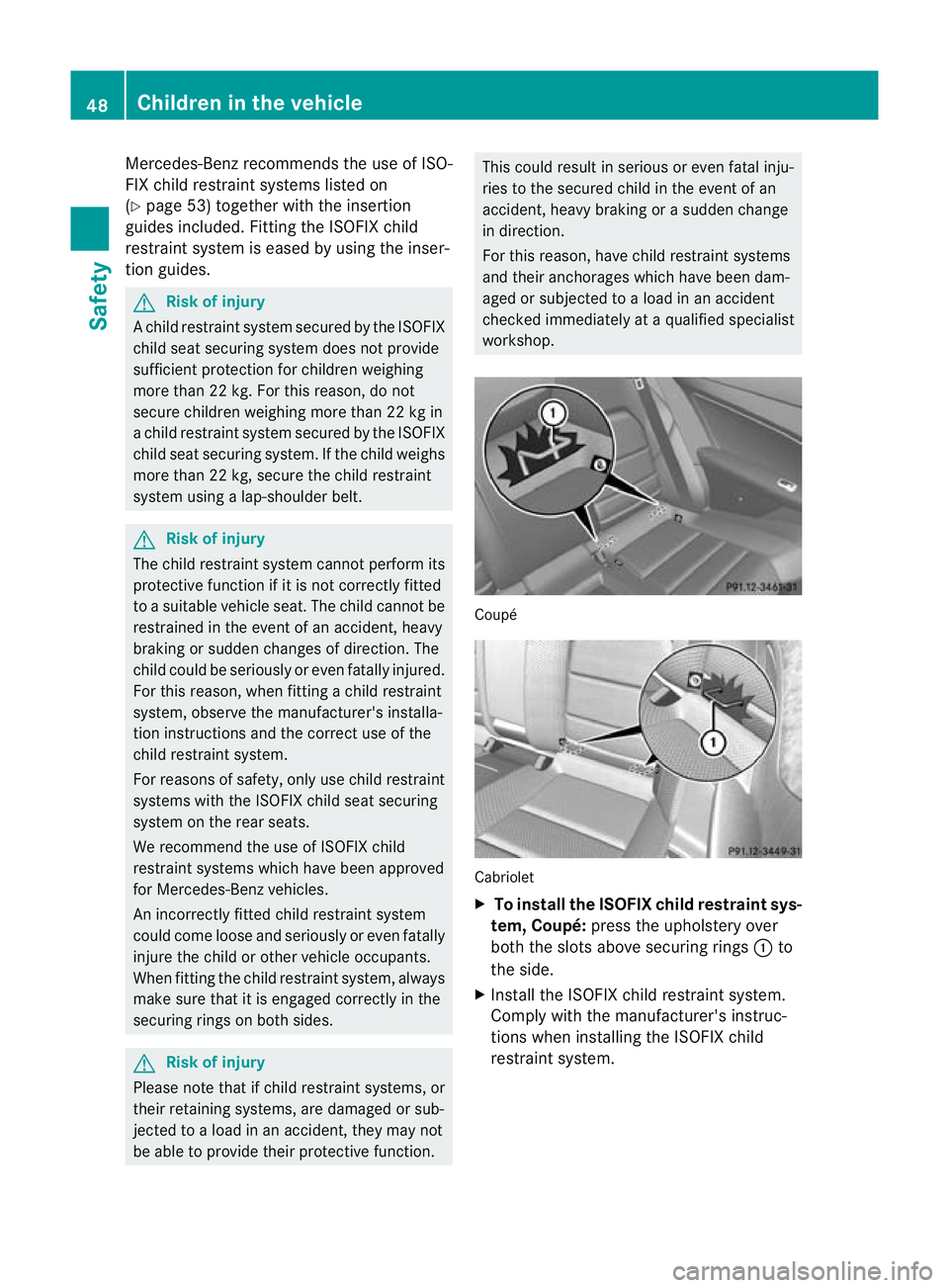
Mercedes-Ben
zrecommends the use of ISO-
FI Xc hild restraint system slisted on
(Y page 53) together with the insertion
guides included. Fitting the ISOF IXchild
restraint system is eased by using the inser-
tio ng uides. G
Risk of injury
Ac hild restraint system secured by the ISOFIX
chil dseat securing system does not provide
sufficien tprotection for children weighing
more than 22 kg. For this reason, do not
secure children weighing more than 22 kg in
ac hild restraint system secured by the ISOFIX
chil dseat securing system. If the child weighs
mor ethan 22 kg, secur ethe chil drestraint
system using alap-shoulde rbelt. G
Risk of injury
The child restraint system can notp erform its
protectiv efunction if it is not correctly fitted
to as uitable vehicle seat. The child cannot be
restrained in the event of an accident, heavy
braking or sudde nchanges of direction. The
chil dcould be seriously or even fatally injured.
For this reason, when fit ting achild rest raint
system, observe the manufacturer's installa-
tion instructions and the correct use of the
child restraint system.
For reasons of safety, only use child restraint
systems with the ISOFIX child seat securing
system on the rear seats.
We recommend the use of ISOFIX child
restraint systems which have been approved
for Mercedes-Benz vehicles.
An incorrectly fitted child restraint system
could come loose and seriously or even fatally
injur ethe chil dorother vehicle occupants.
Whe nfitting the child restraint system, always
make sure that it is engaged correctly in the
securing rings on both sides. G
Risk of injury
Please not ethat if chil drestraint systems, or
their retaining systems, are damaged or sub-
jected to aload in an accident, they may not
be able to provide their protectiv efunction. This could result in serious or even fatal inju-
ries to the secured child in the event of an
accident, heavy braking or
asudden change
in direction.
For this reason, have child restraint systems
and their anchorages which have been dam-
aged or subjected to aload in an accident
chec kedi mmediatel yataqualified specialist
workshop. Coupé
Cabriolet
X
To install the ISOFIX child restraint sys-
tem, Coupé: press the upholstery over
both the slots above securing rings :to
the side.
X Install the ISOFIX child restraint system.
Comply with the manufacturer's instruc-
tions when installing the ISOFIX child
restraint system. 48
Children in th
evehicleSafety
BA 20 7ECE ÄJ 2010/1a; 1; 2, en-GB
mkalafa Version: 3.0.2.11 2010-01-26T13:03:22+01:00-Seite 48
Page 52 of 333
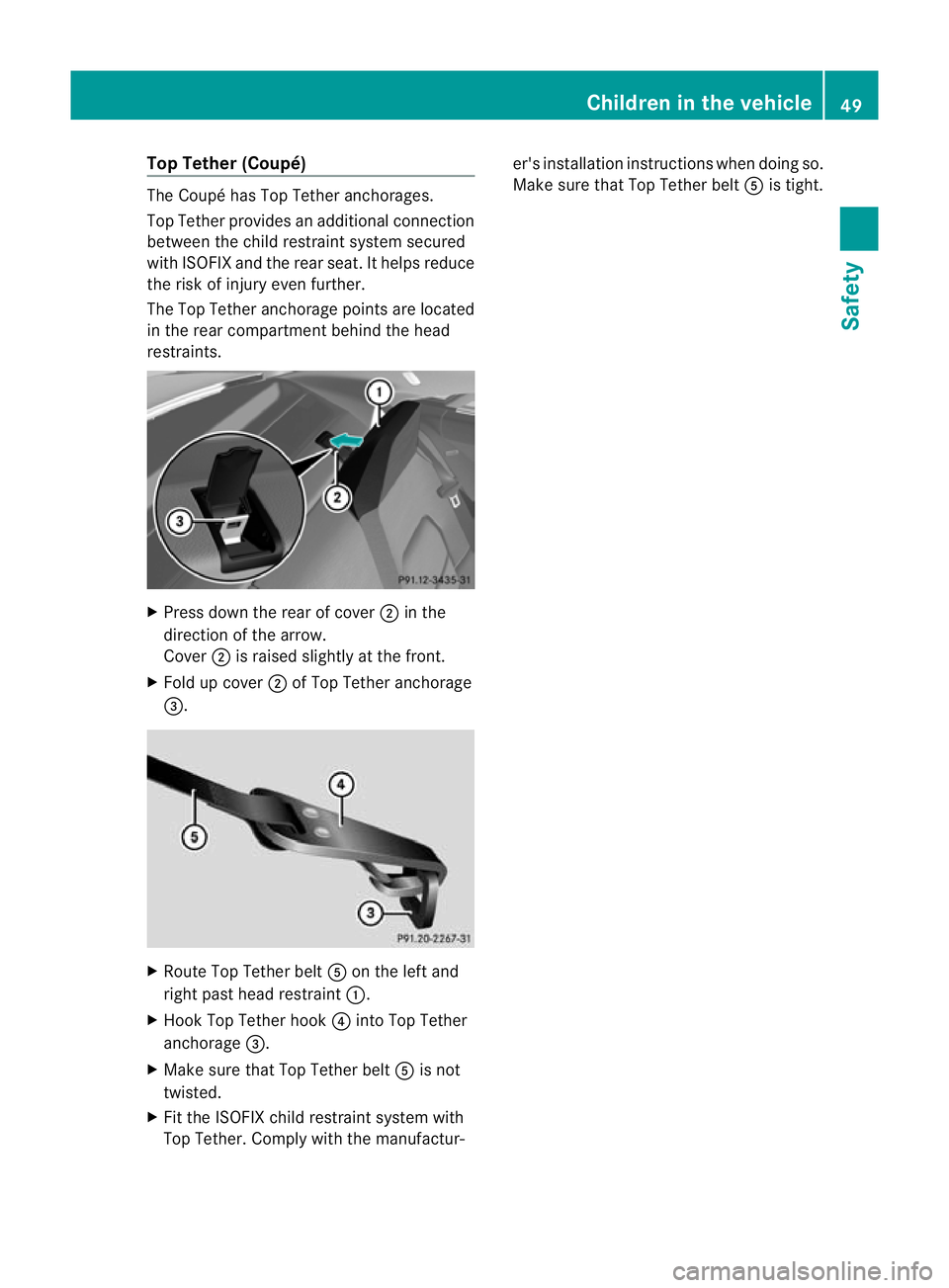
Top Tether (Coupé)
The Coup
éhas Top Tethe ranchorages.
To pT ethe rprovides an additional connecti on
between the child restraint system secured
with ISOFIX and the rear seat. It help sreduce
the risk of injury even further.
The Top Tether anchorage point sare located
in th erear compartmen tbehind the head
restraints. X
Press down the rear of cover ;in the
direc tion of the arrow.
Cover ;is raised slightly at the front.
X Fold up cover ;of Top Tether anchorage
=. X
Rout eTop Tether belt Aon the left and
right past head restraint :.
X Hook Top Tether hook ?intoT op Tether
anchorage =.
X Make sure that Top Tether belt Ais not
twisted.
X Fit the ISOFIX child restraint system with
Top Tether .Compl ywith the manufactur- er'
sinstallatio ninstructions whe ndoing so.
Make sure that Top Tether belt Ais tight. Children in th
evehicle
49Safety
BA 207ECE ÄJ 2010 /1a; 1; 2, en-GB
mkalafa Version: 3.0.2.11 2010-01-26T13:03:22+01:00 -Seite 49 Z
Page 53 of 333
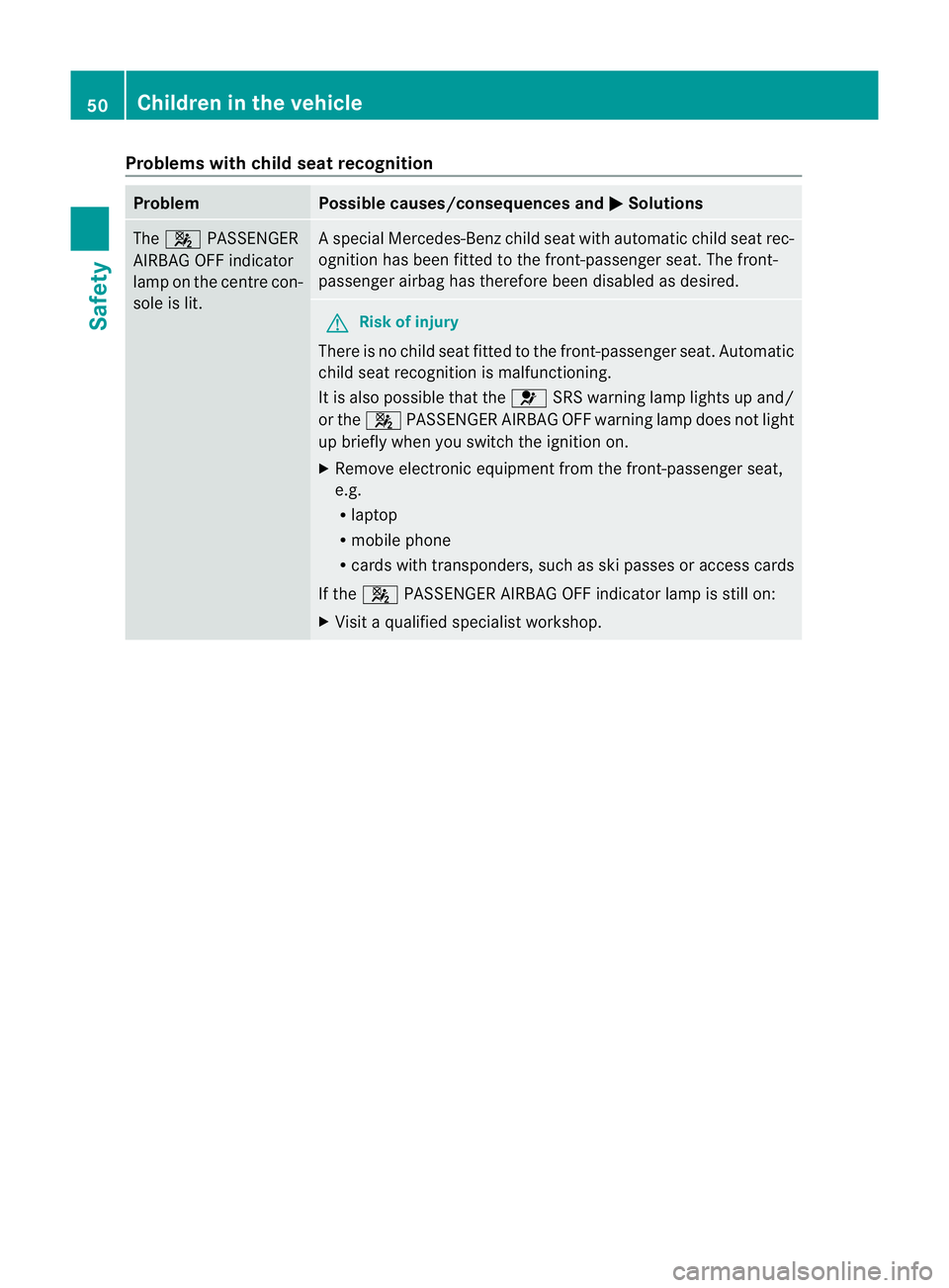
Problems wit
hchilds eat recognition Problem Possible causes/consequences and
M Solutions
The
4 PASSENGER
AIRB AGOFF indicator
lam ponthe cen trecon-
sole is lit. As
pecial Mercedes-Benz child seat with automatic child seat rec-
ognition has been fit tedtot he front-passenger seat. The front-
passenger airbag has therefor ebeen disabled as desired. G
Risk of inju
ry
There is no child seat fit tedtot he front-passenger seat. Aut omatic
chil dseat recognition is malfun ctioning.
It is also possible that the 6SRS warnin glamp lights up and/
or the 4PASSENGER AIRBAG OFF warning lamp does not light
up briefly when you switch the ignition on.
X Remove electronic equipment from the front-passenger seat,
e.g.
R
laptop
R mobile phone
R cards with transponde rs,s uch as ski passes or access cards
If the 4 PASSENGER AIRBAG OFF indicator lamp is still on:
X Visit aqualified specialist workshop. 50
Children in th
evehicleSafety
BA 20 7ECE ÄJ 2010/1a; 1; 2, en-GB
mkalafa Version:3.0.2.11
2010-01-26T13:03:22+01:0
0-Seite 50
Page 54 of 333
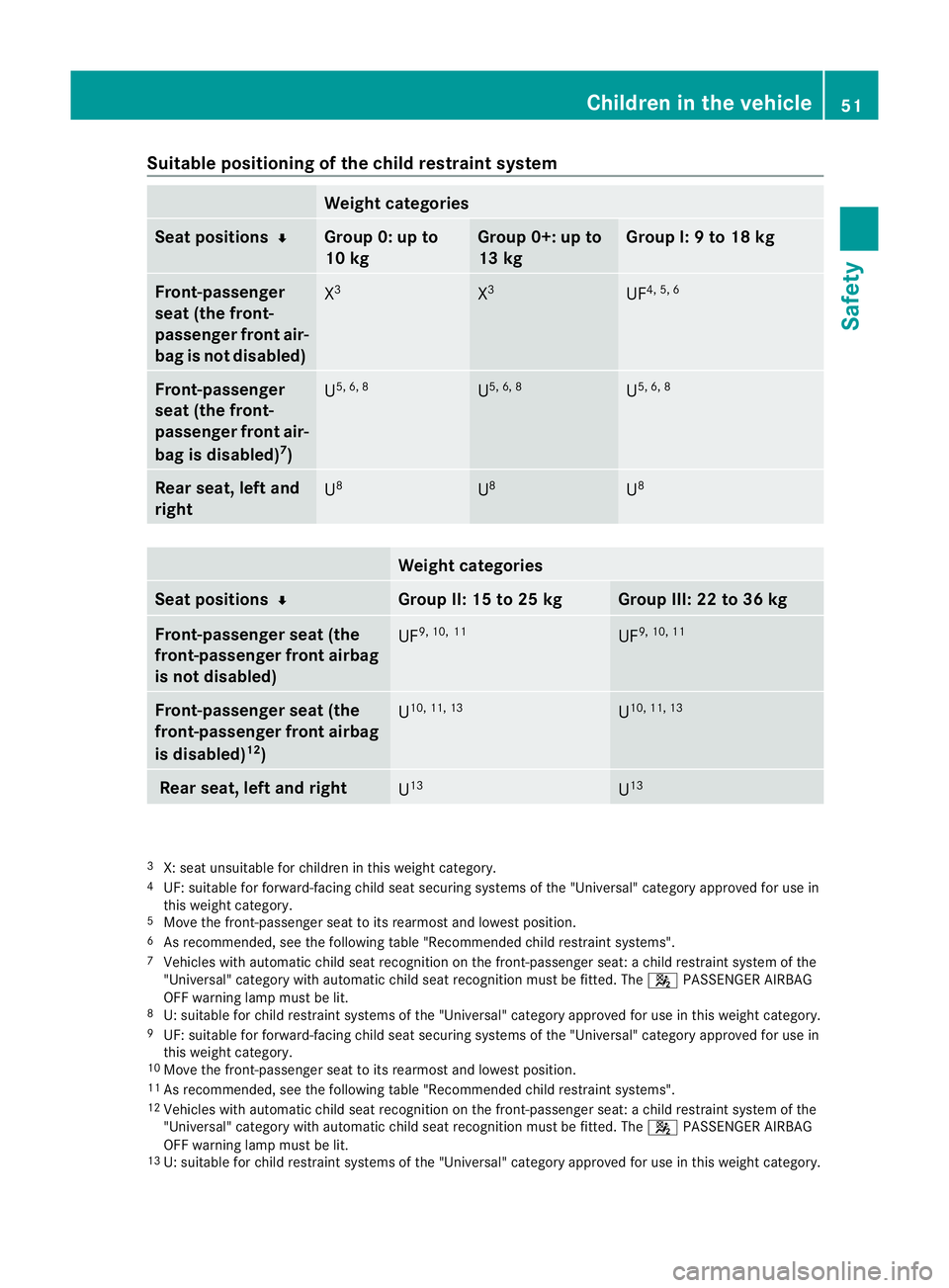
Suitabl
epositioning of the child restraint system Weight categories
Seat positions
¬ Grou
p0:upto
10 kg Group 0+: up to
13 kg Group I:
9to18kg Front-passenger
seat (the front-
passenger front air-
bag is not disabled)
X
3 X
3 UF
4, 5, 6 Front-passenger
seat (the front-
passenger front air-
bag is disabled)
7
) U
5, 6, 8 U
5, 6, 8 U
5, 6, 8 Rear seat, left and
right
U
8 U
8 U
8 Weight categories
Seat positions
¬ Group II: 15 to 25 kg Group III
:22to36kg Front-passenger seat (the
front-passenger front airbag
is not disabled)
UF
9, 10, 11 UF
9, 10, 11 Front-passenger seat (the
front-passenger front airbag
is disabled)
12
) U
10, 11, 13 U
10, 11, 13 Rear seat, left and right
U
13 U
13 3
X: seat unsuitable for children in this weight category.
4 UF: suitable for forward-facin gchild seat securing system softhe "Universal" category approved for use in
this weight category.
5 Move the front-passenger seat to its rearmost and lowest position.
6 As recommended, see the following table "Recommended child restraint systems".
7 Vehicles with automatic child seat recognition on the front-passenger seat: achild restraint system of the
"Universal "category with automatic child seat recognition must be fitted. The 4PASSENGER AIRBAG
OFF warning lamp must be lit.
8 U: suitable for child restraint systems of the "Universal" category approved for use in this weight category.
9 UF: suitable for forward-facing child seat securing systems of the "Universal" category approved for use in
this weight category.
10 Move the front-passenger seat to its rearmost and lowest position.
11 As recommended, see the following table "Recommended child restraint systems".
12 Vehicles with automatic child seat recognition on the front-passenger seat: achild restraint system of the
"Universal "category with automatic child seat recognition must be fitted. The 4PASSENGER AIRBAG
OFF warning lamp must be lit.
13 U: suitable for child restraint systems of the "Universal" category approved for use in this weight category. Childre
ninthe vehic le
51Safety
BA 207ECE ÄJ 2010 /1a; 1; 2, en-GB
mkalafa Version: 3.0.2.11 2010-01-26T13:03:22+01:00 -Seite 51 Z
Page 55 of 333
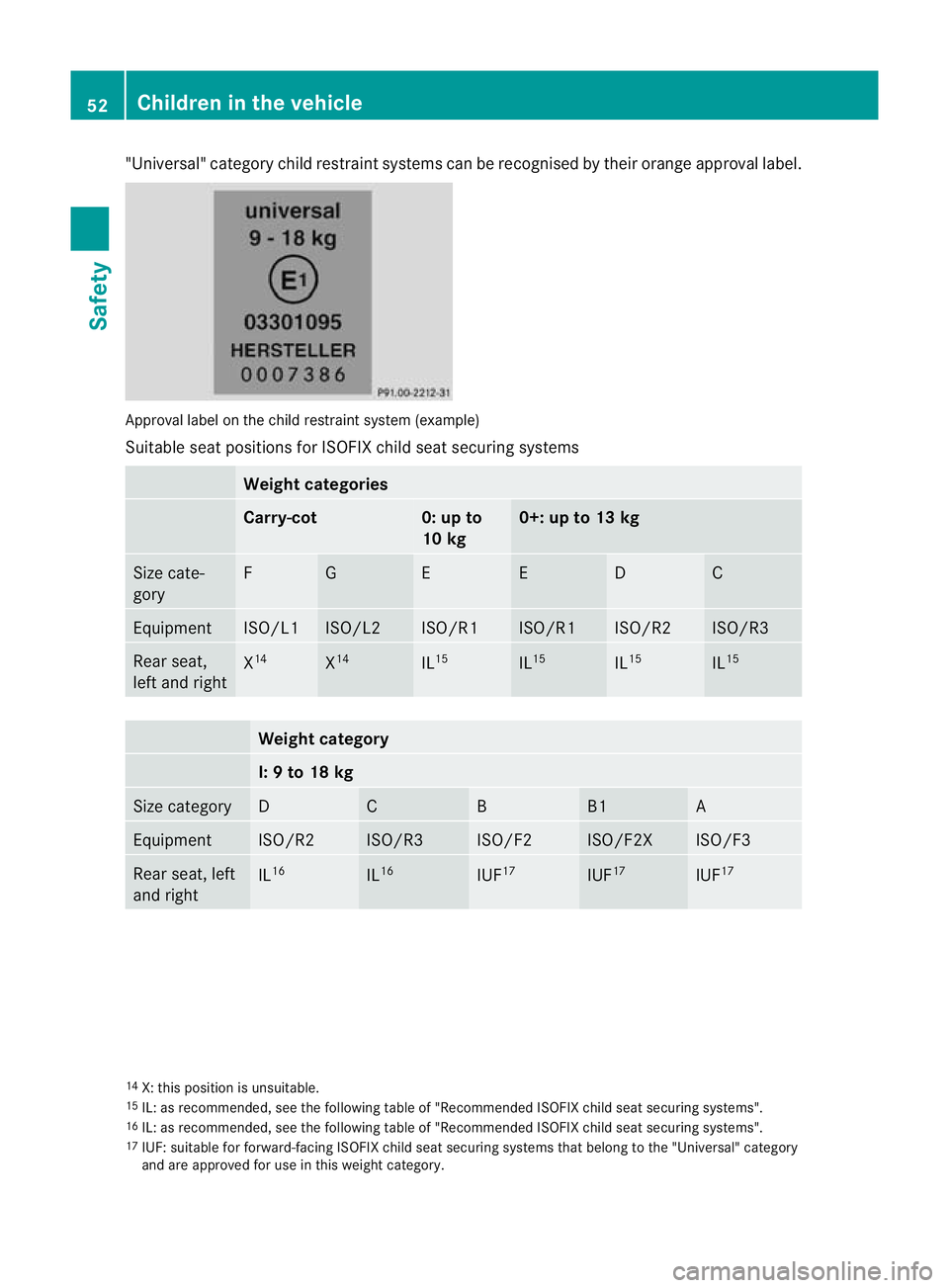
"Universal" category child restraint systems can be recognised by their orange approval label.
Approval label on the child restraint system (example)
Suitable seat positions for ISOFIX child seat securing systems
Weight categories
Carry-cot 0: up to
10 kg 0+: up to 13 kg
Size cate-
gory F G E E D C
Equipment ISO/L1 ISO/L2 ISO/R1 ISO/R1 ISO/R2 ISO/R3
Rear seat,
left and right
X
14 X
14 IL
15 IL
15 IL
15 IL
15 Weight category
I:
9to18kg Size category D C B B1 A
Equipment ISO/R2 ISO/R3 ISO/F2 ISO/F2X ISO/F3
Rear seat, left
and right
IL
16 IL
16 IUF
17 IUF
17 IUF
17 14
X: this position is unsuitable.
15 IL: as recommended ,see the following table of "Recommended ISOFIX child seat securing systems".
16 IL:a sr ecommended, see the following table of "Recommended ISOFIX child seat securing systems".
17 IUF: suitable for forward-facing ISOFIX child seat securing systems that belong to the "Universal" category
and are approved for use in this weight category. 52
Children in the vehicleSafety
BA 20
7ECE ÄJ 2010/1a; 1; 2, en-GB
mkalafa Version: 3.0.2.11
2010-01-26T13:03:22+01:00
-Seite 52
Page 56 of 333
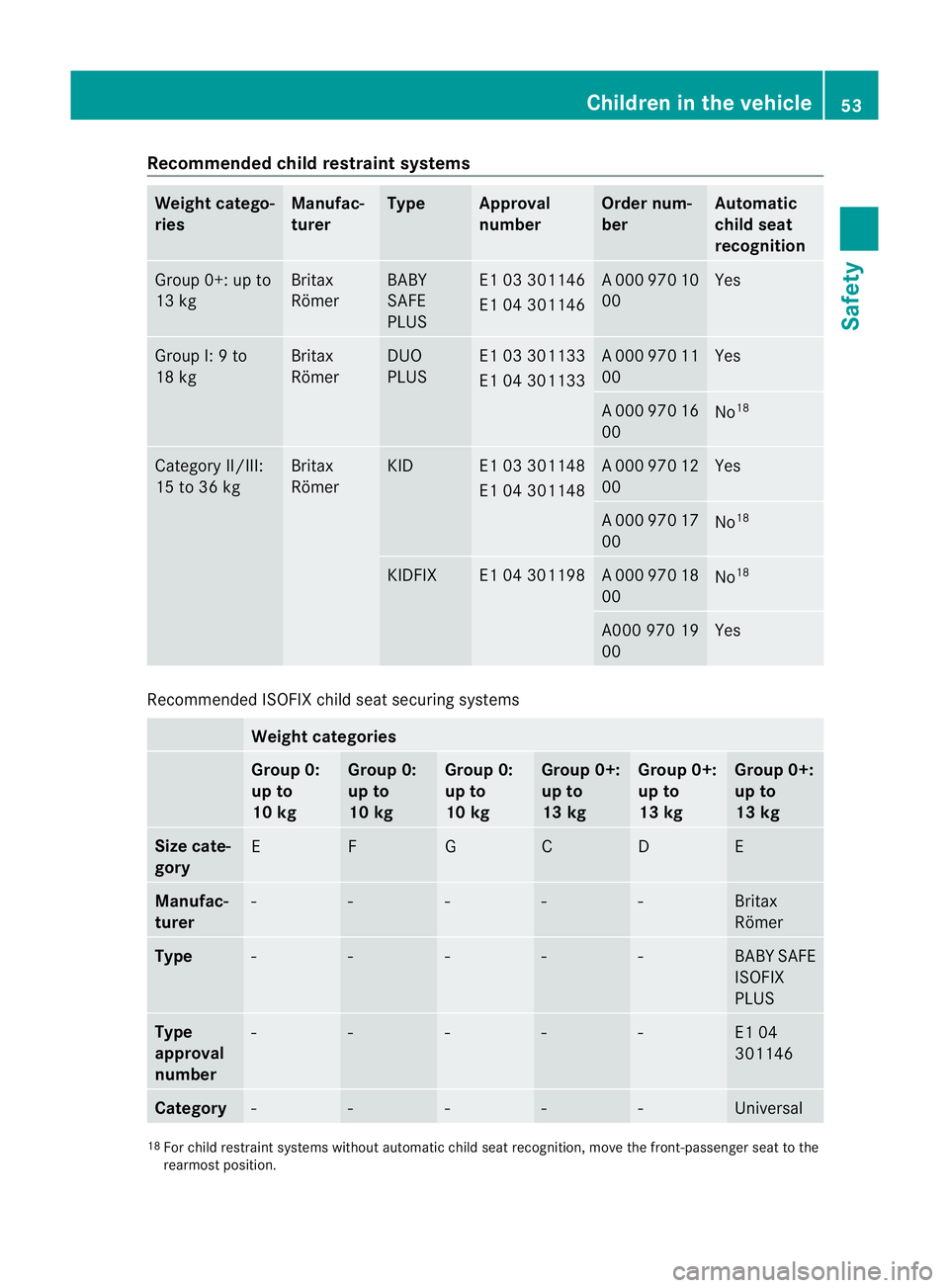
Recommende
dchild restraint systems Weight catego-
ries Manufac-
turer Type Approval
number Ord
er nu m-
ber Automatic
child seat
recognition
Group 0+: up to
13 kg Britax
Römer BABY
SAFE
PLUS E1 03 301146
E1 04 301146 A0
00 970 10
00 Yes
Group I:
9to
18 kg Britax
Römer DUO
PLUS E1 03 301133
E1 04 301133 A0
00 970 11
00 Yes
A0
00 970 16
00 No
18 Categ
oryI I/III:
15 to 36 kg Brit
ax
Römer KID E1 03 301148
E1 04 301148 A0
00 970 12
00 Yes
A0
00 970 17
00 No
18 KIDFIX E1 04 301198 A0
00 970 18
00 No
18 A000 970 19
00 Yes
Recommende
dISOFIX child se at securing systems Weight categories
Group 0:
up to
10 kg Group 0:
up to
10 kg Group 0:
up to
10 kg Group 0+:
up to
13 kg Group 0+:
up to
13 kg Group 0+:
up to
13 kg
Size cate-
gory
E F G C D E
Manufac-
turer
- - - - - Britax
Römer
Type
- - - - - BABY SAFE
ISOFIX
PLUS
Type
approval
number
- - - - - E1 04
301146
Category
- - - - - Universal
18
For child restraint systems without automati cchild seat recognition ,move the front-passenger seat to the
rearmost position. Children in th
evehicle
53Safety
BA 207ECE ÄJ 2010/1a; 1; 2, en-GB
mkalafa Version:3.0.2.11
2010-01-26T13:03:22+01:0
0-Seite 53 Z
Page 57 of 333
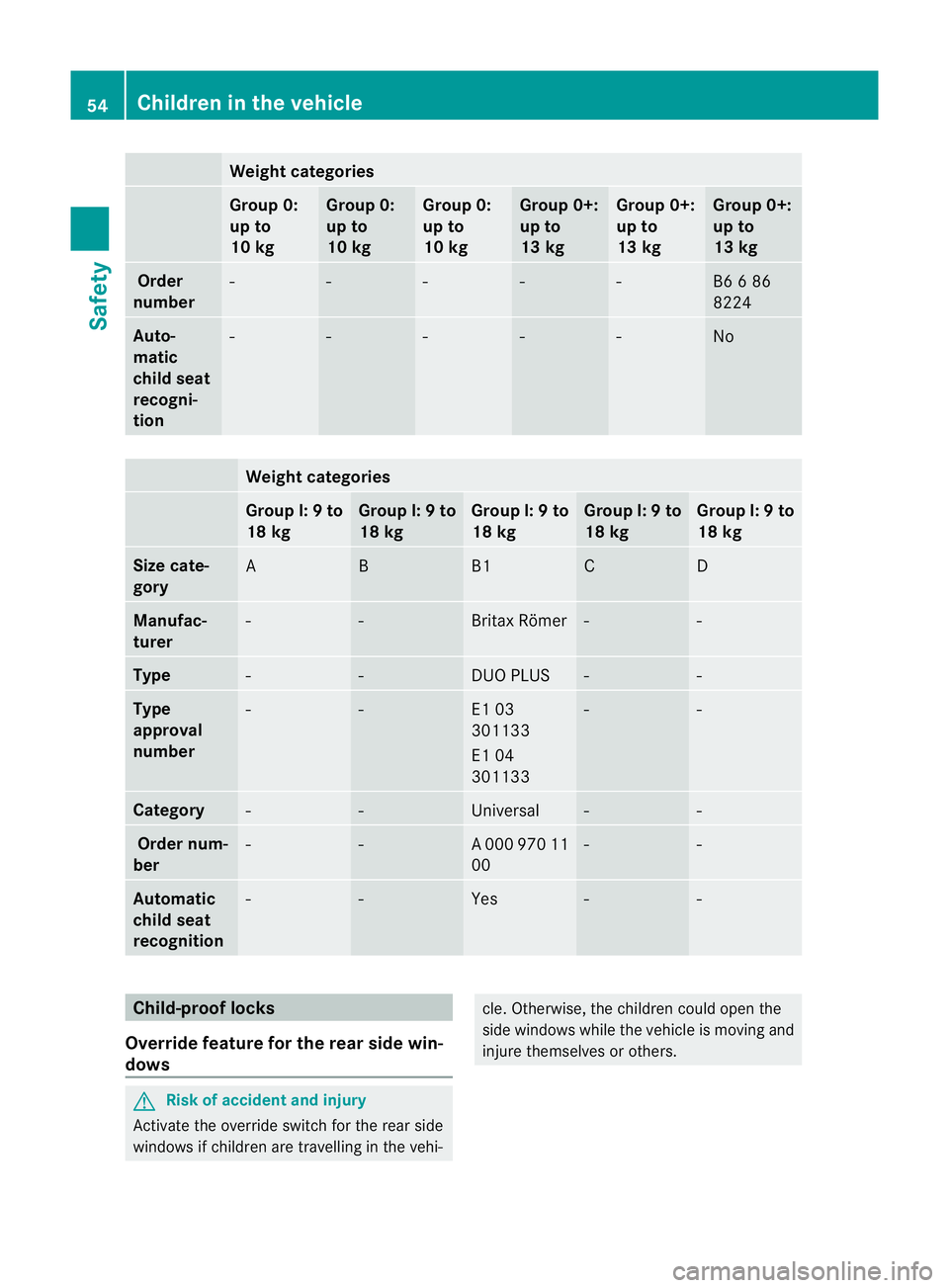
Wei
ghtc ategori es Group 0:
up to
10 kg Group 0:
up to
10 kg Group 0:
up to
10 kg Group 0+:
up to
13 kg Group 0+:
up to
13 kg Group 0+:
up to
13 kg
Order
number - - - - - B6
686
8224 Auto-
matic
chil
dseat
recogni-
tion - - - - - No
Weigh
tcateg ories Grou
pI:9to
18 kg Grou
pI:9 to
18 kg Group I:
9to
18 kg Grou
pI:9 to
18 kg Group I:
9to
18 kg Size cate-
gory
A B B1 C D
Manufac-
turer
- - Britax Römer - -
Ty
pe - - DUO PLUS - -
Type
approval
number
- - E1 03
301133
E1 04
301133 - -
Category
- - Universal - -
Order num-
ber - - A0
00 970 11
00 - -
Automatic
chil
dseat
recognition - - Yes - -
Child-proof locks
Overrid efeature for the rear side win-
dows G
Risk of accident and injury
Activat ethe over ride switch for the rear side
windows if children are travelling in the vehi- cle. Otherwise, the children could open the
side windows while the vehicl
eismovingand
injure themselves or othe rs.54
Children in th
evehicleSafety
BA 20 7ECE ÄJ 2010/1a; 1; 2, en-GB
mkalafa Version:3.0.2.11
2010-01-26T13:03:22+01:0
0-Seite 54
Page 58 of 333
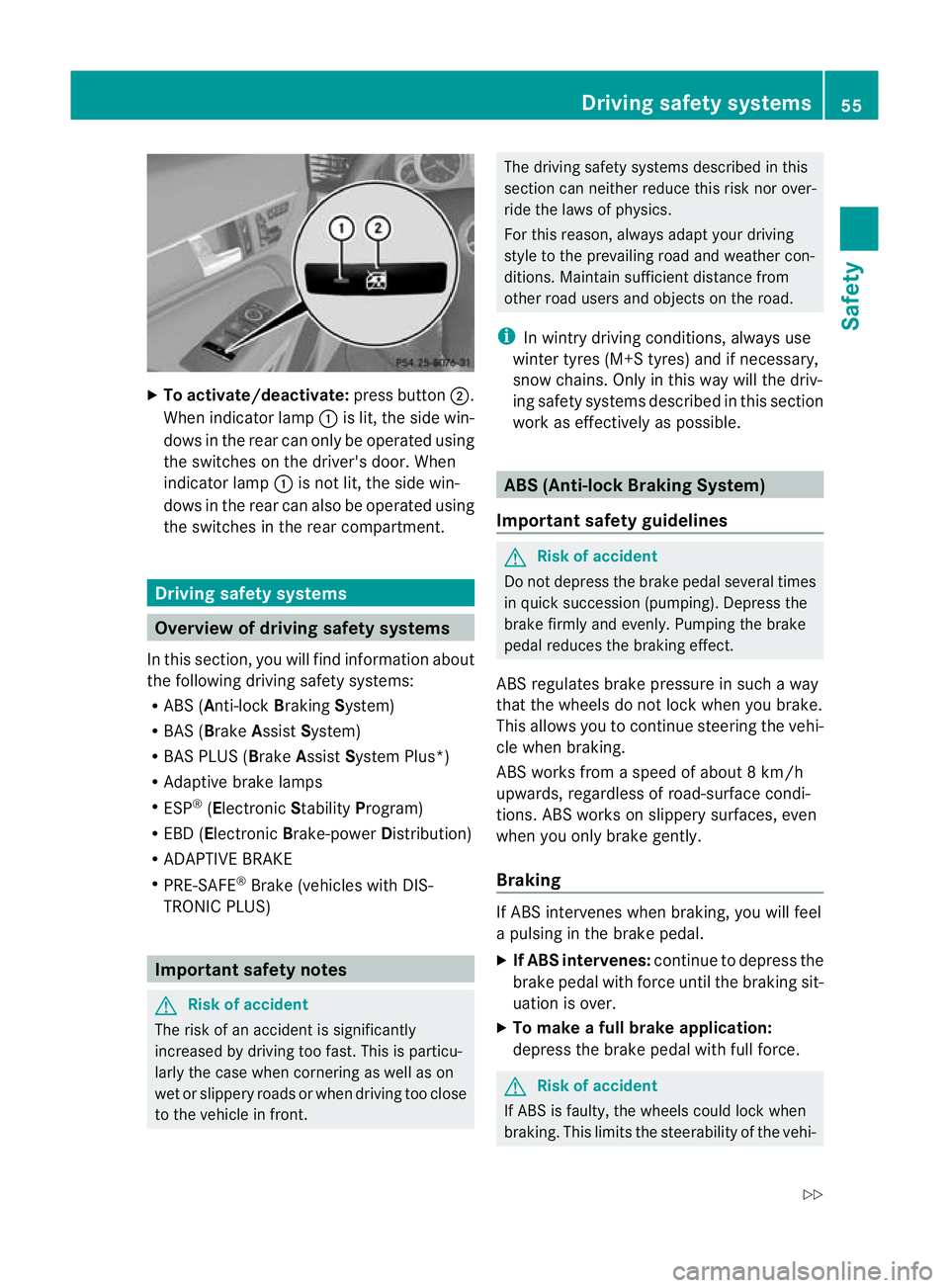
X
To activate/deactivate: press button;.
Whe nindicato rlamp :is lit, the side win-
dows in the rear can only be operated using
the switches on the driver' sdoor .When
indicator lamp :is not lit, the side win-
dows in the rea rcan also be operated using
the switches in the rear compartment. Driving safety systems
Overview of driving safety systems
In this section, you will find information about
the following driving safety systems:
R ABS ( Anti-lock BrakingSystem)
R BAS ( Brake Assist System)
R BAS PLUS ( BrakeAssist System Plus*)
R Adaptive brake lamps
R ESP ®
(Electronic StabilityProgram)
R EBD ( Electronic Brake-power Distribution)
R ADAPTIVE BRAKE
R PRE-SAFE ®
Brake (vehicles with DIS-
TRONIC PLUS) Important safety notes
G
Risk of accident
The risk of an accident is significantly
increased by driving too fast. This is particu-
larly the case when cornerin gaswell as on
wet or slippery roads or when driving too close
to the vehicle in front. The driving safet
ysystems described in this
sectio ncan neither reduce this risk nor over-
ride the laws of physics.
For this reason, always adapt your driving
style to the prevailing road and weather con-
ditions. Maintain sufficient distance from
other road users and objects on the road.
i In wintry driving conditions, always use
winter tyres (M+S tyres) and if necessary,
snow chains. Only in this way will the driv-
ing safety systems described in this section
work as effectively as possible. ABS (Anti-loc
kBrakin gSystem)
Im portan tsafety guidelines G
Ris
kofa ccident
Do not depress the brak epedal several times
in quick succession (pumping). Depress the
brak efirmly and evenly. Pumping the brake
pedal reduces the braking effect.
ABS regulates brake pressure in such away
that the wheels do not lock when you brake.
This allows you to continue steerin gthe vehi-
cle when brakin g.
AB Sw orksfrom aspeed of about 8km/h
upwards, regardless of road-surface condi-
tions. ABS works on slippery surfaces, even
when yo uonly brake gently.
Braking If ABS intervenes whe
nbraking, yo uwill feel
ap ulsing in the brake pedal.
X If ABS intervenes: continue to depressthe
brake pedal with for ceuntil the braking sit-
uation is over.
X To mak eafull brake application:
depress th ebrake peda lwith full force. G
Risk of accident
If ABS is faulty, the wheels could lock when
braking. This limits the steerability of the vehi- Driving safet
ysystems
55Safety
BA 207 ECE ÄJ 2010/1a; 1; 2, en-GB
mkalafa Version: 3.0.2.11 2010-01-26T13:03:22+01:00 -Seite 55 Z
Page 59 of 333
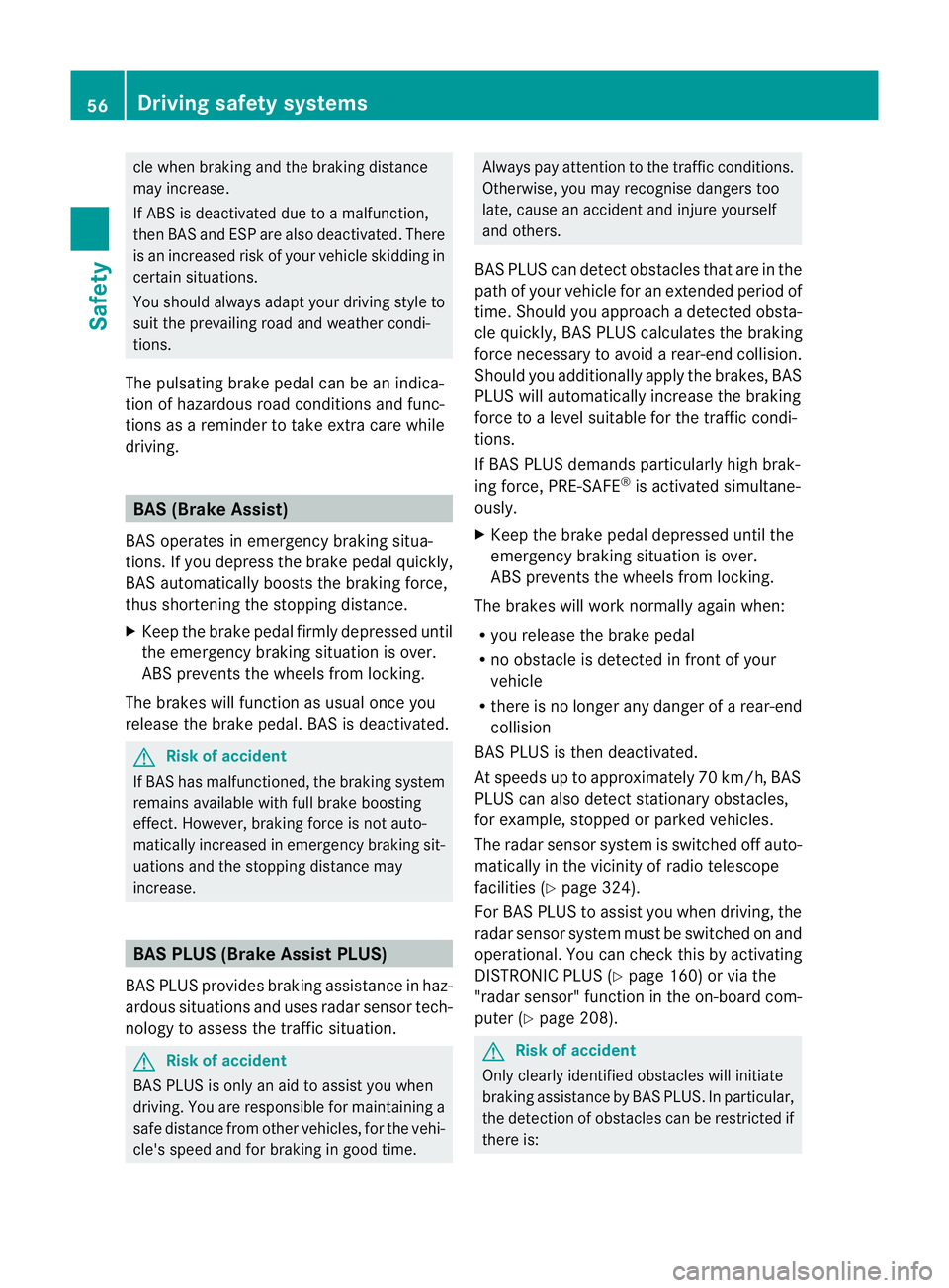
cle whe
nbraking and th ebraking dist ance
may increas e.
If ABS is de activated due to amalfunction,
then BAS and ESP are als odeactivated. There
is an increase drisk of you rvehicle skidding in
cer tain situations.
You should always adapt your drivin gstyle to
suit the prevailing road and weather condi-
tions.
The pulsating brake pedal can be an indica-
tion of hazardous road conditions and func-
tions as areminder to take extra car ewhile
driving. BAS (Br
akeA ssist)
BA So perates in emergency braking situa-
tions. If you depress the brak epedal quickly,
BAS automatically boosts the braking for ce,
thus shortening the stopping distance.
X Keep the brake peda lfirmly depressed until
the emergency brakin gsituation is over.
ABS prevents the wheels from locking.
The brakes will function as usual onc eyou
release the brake pedal. BA Sisd eactiva ted. G
Risk of accident
If BAS has malfunctioned, the braking system
remains available with ful lbrake boosting
effect. However, braking force is not auto-
matically increased in emergency braking sit-
uations and th estoppi ngdistanc emay
increase. BAS PLUS (Brake Assis
tPLUS)
BAS PLU Sprovide sbraking assistance in haz-
ardou ssituation sand use sradar senso rtech-
nology to assess the traffic situation. G
Risk of accident
BAS PLU Siso nly an aid to assist you when
driving. You are responsible for maintaining a
safe distanc efrom other vehicles ,for the vehi-
cle' sspeed and for braking in good time. Alway
spay attention to the traffic conditions.
Otherwise, you may recognise dangers too
late, cause an acciden tand injure yourself
and others.
BAS PLUS can detect obstacle sthat ar einthe
pat hofyour vehicle for an extended period of
time. Should you appr oachad etected obsta-
cle quickly, BA SPLUSc alculates the braking
force necessary to avoid arear-end collision.
Should you additionally apply th ebrakes, BAS
PLUS wil lautomatically increase the braking
force to alevel suitabl efor the traffic condi-
tions.
If BA SPLUS demands particularl yhigh brak-
ing force, PRE-SAFE ®
is activated simultane-
ously.
X Keep the brak epedal depressed until the
emergency braking situation is over.
AB Sp revents th ewheels fr om lockin g.
The bra kesw ill work normally again when:
R you release the brak epedal
R no obstacle is detected in fr ontof your
vehicle
R there is no longer any danger of arear-end
collision
BA SP LUS is then deactivated.
At speeds up to appro ximately 70 km/h ,BAS
PLU Scan also detect stationary obstacles,
for example, stopped or parked vehicles.
The radar sensor system is switched off auto-
matically in the vicinit yofradio telescope
facilities (Y page 324).
For BA SPLUS to assist yo uwhen driving, the
radar sensor system must be switched on and
operational. You can chec kthis by activating
DI ST RONIC PLUS (Y page 160) or via the
"rada rsensor "function in the on-board com-
puter (Y page 208). G
Risk of accident
Only clearly identified obstacles will initiate
brakin gassistanc ebyBAS PLUS. In particular,
the dete ction of obstacles can be restricted if
there is: 56
Drivin
gsafety systemsSafety
BA 207 ECE ÄJ 2010/1a; 1; 2, en-GB
mkalafa Version: 3.0.2.11
2010
-01-26T13:03:22+01:00 -Seite 56
Page 60 of 333
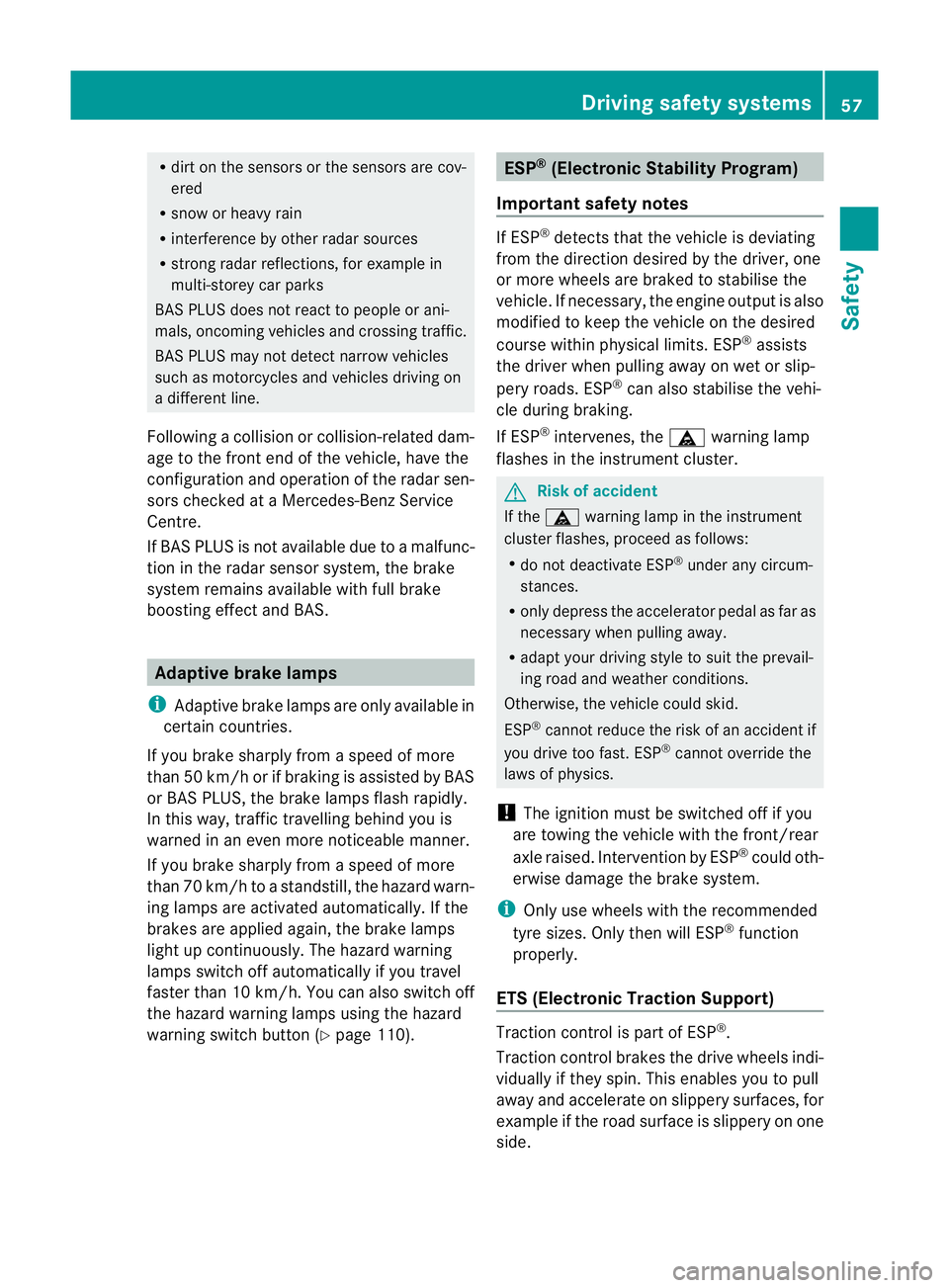
R
dirt on the sensor sorthe sensor sare cov-
ered
R sno worh eavy rain
R interferenc ebyother radar sources
R strong radar reflections, for example in
multi-storey car parks
BA SP LUS does no treact to people or ani-
mals, oncomin gvehicles and crossin gtraffic.
BAS PLUS may not detect narrow vehicles
such as motorcycle sand vehicles driving on
ad ifferen tline.
Following acollision or collision-related dam-
age to the fron tend of the vehicle, have the
configuratio nand operatio nofthe radar sen-
sors chec kedataM ercedes-Ben zService
Centre.
If BAS PLU Sisn ot available due to amalfunc-
tion in the radar senso rsystem, the brake
syste mremains available with ful lbrake
boostin geffect and BAS. Adaptiv
ebrake lamps
i Adaptive brake lamps are only available in
certain countries.
If you brake sharply from aspeed of more
than 50 km/ horifbraking is assisted by BAS
or BAS PLUS, th ebrake lamp sflash rapidly.
In this way, traffic travelling behind you is
warned in an even more noticeable manner.
If you brake sharply from aspeed of more
than 70 km/ htoastandstill, the hazard warn-
ing lamps are activated automatically .Ifthe
brakes ar eapplied again, the brak elamps
light up continuously .The hazard warning
lamps switc hoff automatically if you travel
faster than 10 km/h .You can also switc hoff
th eh azard warning lamps using the hazard
warning switch button (Y page 110). ESP
®
(Electronic Stability Program)
Important safety notes If ESP
®
detect sthat the vehicle is deviating
from the direction desired by the driver ,one
or more wheels are braked to stabilis ethe
vehicle. If necessary, the engin eoutput is also
modified to keep the vehicle on the desired
course within physical limits. ESP ®
assists
the driver when pulling away on wet or slip-
pery roads. ESP ®
can also stabilise the vehi-
cle during braking.
If ESP ®
intervenes, the äwarning lamp
flashes in the instrument cluster. G
Risk of accident
If the ä warning lamp in the instrument
cluster flashes, proceed as follows:
R do not deactivate ESP ®
under any circum-
stances.
R only depress the accelerator pedal as far as
necessary when pulling away.
R adapt your driving style to suit the prevail-
ing road and weather conditions.
Otherwise ,the vehicle coul dskid.
ESP ®
cannot reduce the risk of an accident if
you drive too fast. ESP ®
cannot override the
laws of physics.
! The ignition must be switched off if you
are towing the vehicl ewith the front/rear
axle raised. Interven tion by ESP ®
coul doth-
erwise damage the brake system.
i Only use wheels with the recommended
tyre sizes. Only then will ESP ®
function
properly.
ETS (Electronic Traction Support) Traction control is part of ESP
®
.
Traction control brakes the drive wheels indi-
viduall yifthey spin. This enables you to pull
away and accelerate on slipper ysurfaces, for
example if the road surface is slippery on one
side. Driving safety systems
57Safety
BA 207 ECE ÄJ 2010/1a; 1; 2, en-GB
mkalafaV ersion: 3.0.2.11
2010-01-26T13:03:22+01:00
-Seite 57 Z